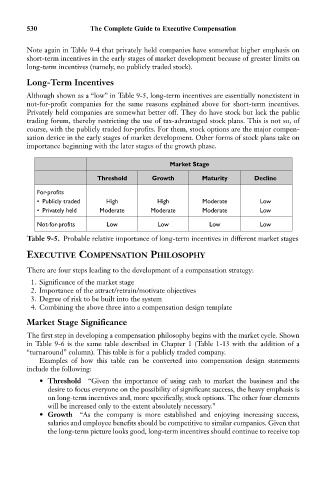Page 544 - Bruce Ellig - The Complete Guide to Executive Compensation (2007)
P. 544
530 The Complete Guide to Executive Compensation
Note again in Table 9-4 that privately held companies have somewhat higher emphasis on
short-term incentives in the early stages of market development because of greater limits on
long-term incentives (namely, no publicly traded stock).
Long-Term Incentives
Although shown as a “low” in Table 9-5, long-term incentives are essentially nonexistent in
not-for-profit companies for the same reasons explained above for short-term incentives.
Privately held companies are somewhat better off. They do have stock but lack the public
trading forum, thereby restricting the use of tax-advantaged stock plans. This is not so, of
course, with the publicly traded for-profits. For them, stock options are the major compen-
sation device in the early stages of market development. Other forms of stock plans take on
importance beginning with the later stages of the growth phase.
Market Stage
Threshold Growth Maturity Decline
For-profits
• Publicly traded High High Moderate Low
• Privately held Moderate Moderate Moderate Low
Not-for-profits Low Low Low Low
Table 9-5. Probable relative importance of long-term incentives in different market stages
EXECUTIVE COMPENSATION PHILOSOPHY
There are four steps leading to the development of a compensation strategy:
1. Significance of the market stage
2. Importance of the attract/retrain/motivate objectives
3. Degree of risk to be built into the system
4. Combining the above three into a compensation design template
Market Stage Significance
The first step in developing a compensation philosophy begins with the market cycle. Shown
in Table 9-6 is the same table described in Chapter 1 (Table 1-13 with the addition of a
“turnaround” column). This table is for a publicly traded company.
Examples of how this table can be converted into compensation design statements
include the following:
• Threshold “Given the importance of using cash to market the business and the
desire to focus everyone on the possibility of significant success, the heavy emphasis is
on long-term incentives and, more specifically, stock options. The other four elements
will be increased only to the extent absolutely necessary.”
• Growth “As the company is more established and enjoying increasing success,
salaries and employee benefits should be competitive to similar companies. Given that
the long-term picture looks good, long-term incentives should continue to receive top

